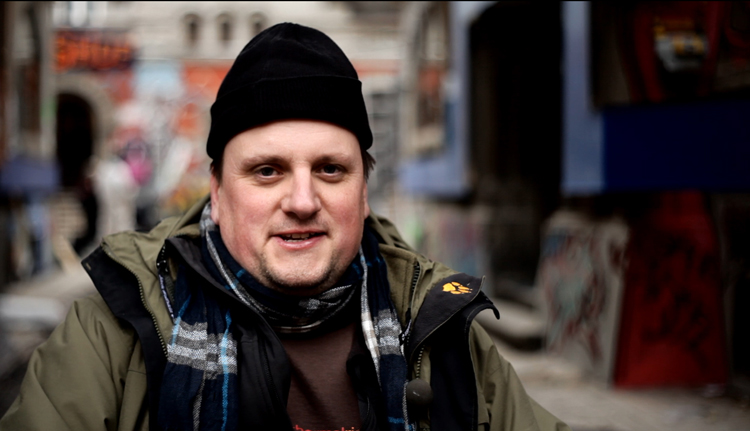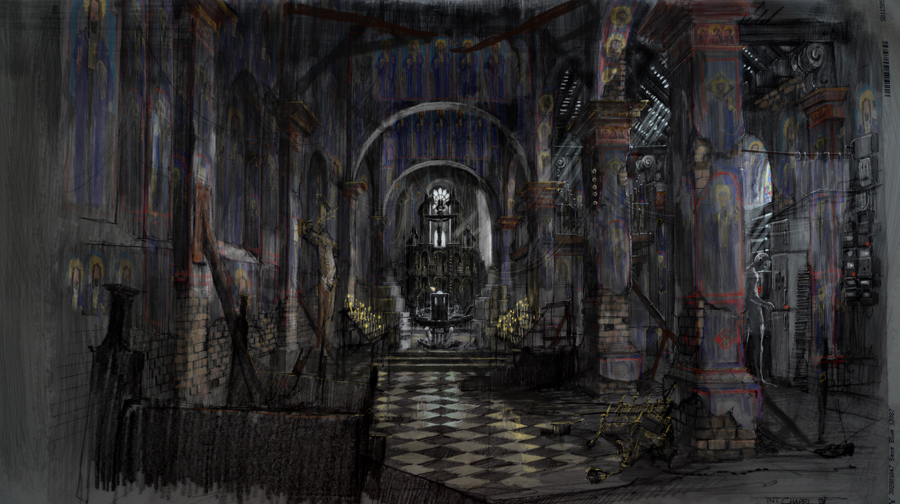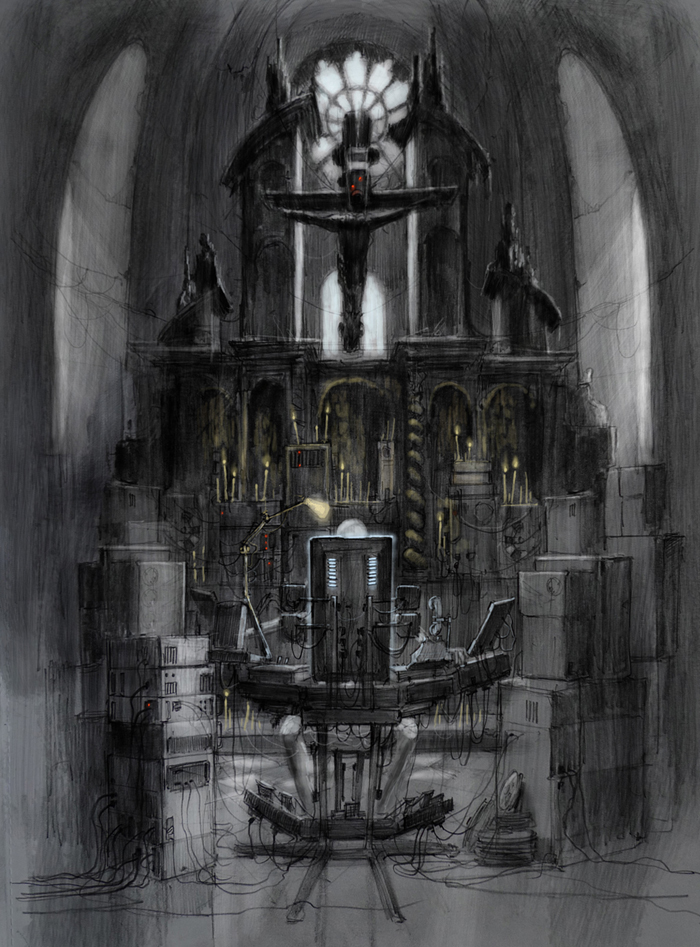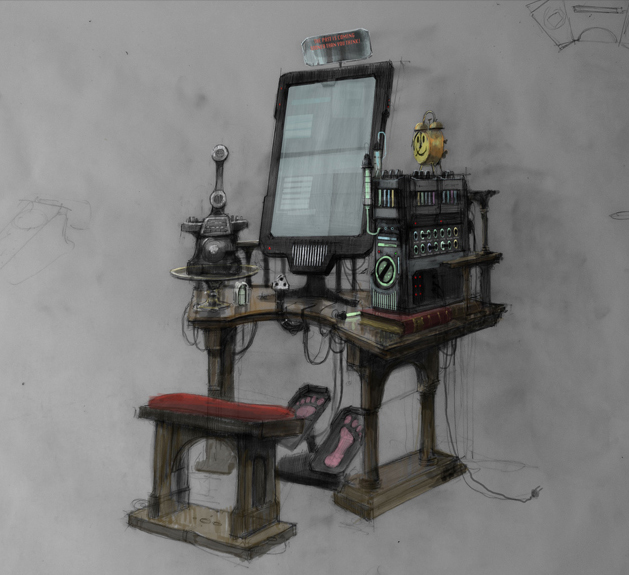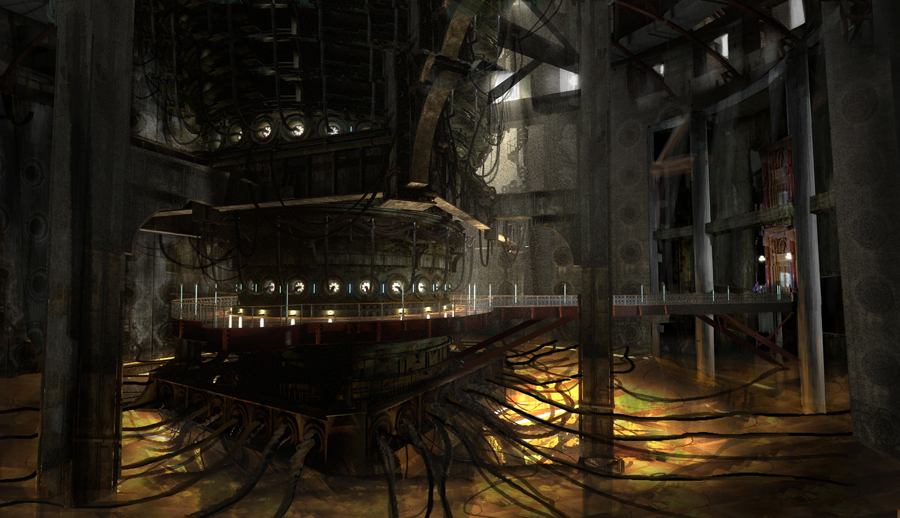Spreading milk over the infinite table-top
David Warren, Production Designer for The Zero Theorem, talks to Dreams
Featuring four examples of artwork from The Zero Theorem
| On day 28 of the shooting schedule of The Zero Theorem, the
main crew was at the ICPE laboratory in city centre Bucharest, to
shoot the sequence where Qohen (Christoph Waltz) discusses his condition
with a panel of three doctors. Meanwhile, Production Designer David
Warren was working with his team preparing the exterior of Qohen's
chapel for the next day's shooting. The interior chapel scenes were shot in the MediaPro studios, but the chapel exterior was shot at 41 Strada Grigore Cobălcescu in Bucharest. This is where David found a few moments to talk about his work on the project.
Phil Stubbs: What have you been working on today? David Warren: Surviving... staying in a paid job! This morning I got up very early. I'd got back from the laboratory set quite late. I got back to the hotel before Terry. It was one of the few times on the movie I got back to the hotel before Terry because they did four hours overtime last night on the chapel set. I walked in to the hotel room, opened my computer, and started emailing the missus. My eyelids started to go, and it was suddenly 4am. I had been out like a light for seven hours, and then oh my God; we've got to go to work. It was as if the sleep was stolen. I was still in my clothes and everything. Anyway… I went to set early; we handed over the set to the director, which was the very nice health board laboratory set, I'm sure he liked it. And now I've come here to Cobălcescu, which is where Qohen's chapel exterior is. As you can see behind me, we are still scuttling around putting things into place and painting it and dressing it, things like that. This is our world. Some of it you can see, some of it we put in ourselves. Look, there's smoke there already. The apartment block was here already, I have to admit. The little chapel, we put that in. The graffiti is ours, which has changed the character of the alleyway to our world, or as we like to phrase it… "Terry's vision", which is very colourful in this film. What experience did you have at the Athenaeum, where you filmed Qohen's office? It was a combination of stress, sleep deprivation - and euphoria when we walked away from it. It was a hard one because the Athenaeum is a very beautiful location and we shot in the lobby of the big concert hall here, and we put a set in like a merry-go-round / carousel. It's based on many different references, the main one is Wall Street but it's in lots of candy colours, and it has the feeling of a pinball machine, or something like that, which let's be honest is what investment banking is all about! We started at 4am and going until 4pm because we had to avoid the concerts. And every now and then we had to pack our stuff away because you'd see all these people in penguin suits with their programmes on the way to watch a bit of Brahms and Liszt. Yes it got built; I think Terry was very happy. Everybody seems to be very happy with our stuff, or if they're not, they're not telling me!
Can you tell me about the challenges in building the chapel? Apart from the financial ones! We've got chapels in my own town Gloucester, and in Britain a chapel actually is a little tin shed with a cross on it. And we built a cathedral with 10% taken out! They call it Qohen's cathedral at the studio. It was a strange one because we came to Bucharest, we had a look round at the Orthodox churches here, and they have a very different architecture than Anglican or catholic churches or other denominations, the way the interior is plotted out. We did like the fact that they are heavily frescoed or painted with all these saints. And Terry all the way through liked saying Qohen is agoraphobic but is surrounded by faces all the time. There are faces at screen at work, there are faces following him around in the advertising and even when he gets in his little burnt-out chapel there are faces everywhere. We did it as a painted interior which I think English churches were a very long time ago until Oliver Cromwell painted them all white (or was it Henry VIII, I can't remember… anyway somebody did). So it has got an Orthodox Church interior feel. But the actual way it is planned out and plotted out is more like an Anglican church: it has got an organ loft, a high altar at one end, and an entrance vestibule at another end.
How long did it take to build the chapel? We were right to the wire on it. I think it was nine weeks. We had painters in there on the ninth week. It was supposed to be seven, but there are always details, and Terry makes notes, and things needed to be changed. Just at the end there's lots of snagging and tidying up. Seven weeks got the bulk of it up. Another week of snagging and notes and then a final week of touches, and that was it dressed. When I turned up here in Bucharest, I had some drawings to get going with, but we started carpenters on the second week I was here for a ten-week preproduction so it was a nine-week build.
How did you reach the design for of Mancom, the large computer? I more or less arrived when Terry did, our first time in Bucharest. We went to have a look at a few different places, and there was something that MediaPro had sent to us which was a big blast furnace, a wrecked one in an old pre-Ceausescu factory for making steel or iron or something. It was a great looking building, but impossible to shoot in, and two hours away from the city. It was a 45 foot diameter concrete and iron tower with all these portholes in it, masses of structure, very dilapidated. We thought: can we shoot in here? Can this be the mainframe? Obviously at the moment thanks to (God rest his soul) Mr Jobs, everybody else out there is trying to make computers tiny: little phones with fantastic cameras. We thought what if in the future it all goes the other way, and size becomes really important, and computers are maximal, they're fat, and chunky, with big screens. If Mancom had the biggest one of the lot, it should be colossal, because it is meant to hold all this entity information. The whole planet, the whole population, all their wants, desires, needs, products - everything is inside this thing, so we thought it's got to be big. Let's say it's steam-powered, it's iron, concrete, it's made out of old materials, this thing was probably built 50 years ago, and it's still there pumping away, trying to get all this stuff inside it. We referenced Mancom very strongly to this blast furnace, and we ended up building it as a set with a green screen around it, just to have something operational we could work with, something we could adapt. It blows up at one point, and it's a very difficult thing to do when it really is made of concrete so that's why we went in that direction. And I think it was to buck the trend of miniaturisation. Why do you want a little computer like that when you can have something the size of the Titanic?
What has working with Terry been like on this project? I get asked that every time, I haven't got a fucking clue any more, I really don't. It's hard work, but working in film is hard work. It shouldn't be: it's not brain surgery. It is hard because Terry is interested… I was trying to explain to somebody this morning. It's not that he is interested in the Art Department; he's interested in all departments. He's interested in the engineering of filmmaking, of how stuff is done. Whether you are special effects, wardrobe, hair & make-up, or set design, he's really, really into it. Has it been enjoyable? It's been hard. At the beginning, Terry was so funny. Two things he said: We shouldn't be doing this if it is not fun, because the resources are slim, it's low budget. Why would we go if we are not having fun? The other thing is because I'm going to pull all these people whether it's Christoph, Nicola or me, and they are not getting paid what they would normally get paid, at least they should have the satisfaction of doing a good job. Can you imagine that! But we have done, I think. We are working within margins, and you always have to work within margins. Even if you are doing films that are ten or fifteen times the size of this one, you still have limits you've got to work to and I think our limits are very tight, which means in producer-speak, "you have to think creatively". You need to make the money stretch like a thin cream of UHT milk over an infinite table-top, which I suppose is what we've done. They've been a terrific gang, they really have [the Art Department]. Everything we've wanted to do… it's interesting because when you read the script, the Carol Park, the exterior park - this is what working with Terry is like… You could say park, trees, kids... give me some stuff. We ended up shooting at a massive post-war communist war memorial, and we filled it with huge inflatable blue arches and spikes and we had pederasts walking around, and a guy dressed in a clown suit with a huge hot dog stand and Christ knows what else, and that is what working with Terry is like because he goes there. This is an astonishingly strange location, nobody has seen it before, and then we are going to make it more weird, so whatever is written on the page… all you need to read is exterior park. Don't read the stage direction, because we are going to do this now. And that's what happened. We'll have a guy selling balloons. Then a kid buys a lot of balloons and then he goes up in the air with one. I remember that as well and thinking it's not written in the script. But that is what it is like: you just say yes, how many balloons do you want? Good, we'll do it. And that's the way you do it really, and we keep going. We all go home hopefully. He's still got to do postproduction - and my phone will be off! POSTSCRIPT - unfortunately for David, he accidentally left his phone on and was heavily involved in postproduction. This will be the subject of a further conversation with David here at Dreams in the next few weeks. More on The Zero Theorem from Dreams |
